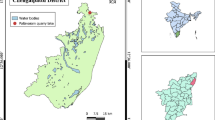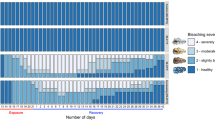Abstract
Monthly changes in sedimentation and sediment properties were studied for three different culture treatments: sea cucumber monoculture (Mc), sea cucumber and scallop polyculture (Ps-c) and scallop monoculture (Ms). Results indicated that the survival rate of sea cucumber was significantly higher in Ps-c cultures than in Mc cultures. Sea cucumber yield was 69.6% higher in Ps-c culture than in Mc culture. No significant differences in body weight and scallop shell length were found between Ps-c and Ms cultures. The mean sedimentation rate of total particulate matter (TPM) was 72.2 g/(m2·d) in Ps-c cultures, with a maximum of 119.7 g/(m2·d), which was markedly higher than that of Mc (mean value). Sedimentation rates of organic matter (OM), total organic carbon (TOC), total nitrogen (TN) and total phosphorus (TP) in Ps-c cultures were also significantly higher than those in Mc cultures. TOC and TN contents of sediment increased rapidly in the first 5 months in Ms cultures and remained at a high level. TOC and TN contents in Mc and Ps-c cultures decreased during sea cucumber feeding seasons and increased during sea cucumber dormancy periods (summer and winter). The study demonstrates that co-culture of sea cucumber and scallop in earthen ponds is an alternative way to alleviate nutrient loads and improve water quality in coastal aquaculture systems. Moreover, it provides the additional benefit of an increased sea cucumber yield.
Similar content being viewed by others
References
Ahlgren M O. 1998. Consumption and assimilation of salmon net pen fouling debris by the red sea cucumber Parastichopus californicus: Implications for polyculture. J. World Aquac. Soc., 29: 133–139.
Byers S C, Mills E L, Stewart P L. 1978. A comparison of methods of determining organic carbon in marine sediments with suggestions for a standard method. Hydrobiologia, 58: 43–48.
Chang Y Q. 2007. Aquaculture and Multiplication of Molluscs. China Agriculture Press, Beijing, China. p.31–32. (in Chinese)
Chen J X. 2003. Overview of sea cucumber farming and sea ranching practices in China. S. P. C. Bêche-de-mer Information Bull., 18: 18–23.
Christensen P B, Glud R N, Dalsgaard T, Gillespie P. 2003. Impacts of longline mussel farming on oxygen and nitrogen dynamics and biological communities of coastal sediments. Aquaculture, 218: 567–588.
Danovaro R, Croce N D, Dell’Anno A, Fabiano M, Marrale D, Martorano D. 2000. Seasonal changes and biochemical composition of the labile organic matter flux in the Cretan Sea. Prog. Oceanogr., 46: 259–278.
Fabiano M, Danovaro R, Fraschetti S. 1995. A three-year time series of elemental and biochemical composition of organic matter in subtidal sediments of the Ligurian Sea (northwestern Mediterranean). Contin. Shelf. Res., 15: 1 453–1 469.
Gerino M, Stora G, Poydenot F, Bourcier M. 1995. Benthic fauna and bioturbation on the Mediterranean continental slope: Toulon Canyon. Contin. Shelf. Res., 15: 1 483–1 496.
Gilbert F, Souchu P, Bianchi M, Bonin P. 1997. Influence of shellfish farming activities on nitrification, nitrate reduction to ammonium and denitrification at the water-sediment interface of the Thau Lagoon, France. Mar. Ecol. Prog. Ser., 151: 143–153.
Grant J, Hatcher A, Scott D B, Pocklington P, Schafer C T, Winters G V. 1995. A multidisciplinary approach to evaluating impacts of shellfish aquaculture on benthic communities. Estuaries, 18: 124–144.
Grémare A, Amoroux J M, Charles F, Dinet A, Riaux-Gobin C, Baudart J, Edernach M L, Bodiou J Y, Vétion G, Colomines J C, Albert P. 1997. Temporal changes in the biochemical composition and nutritional value of the particulate organic matter available to surface deposit-feeders: a two year study. Mar. Ecol. Prog. Ser., 150: 195–206.
Grenz C, Hermin M, Baudinet D, Daumas R. 1990. In situ biochemical and bacterial variation of sediments enriched with mussel bio-deposits. Hydrobiologia, 207: 153–160.
Kautsky N, Evans S. 1987. Role of bio-deposition by Mytilus edulis in the circulation of matter and nutrients in a Baltic coastal system. Mar. Ecol. Prog. Ser., 38: 201–212.
Mallet A L, Carver C E, Landry T. 2006. Impact of suspended and off-bottom Eastern oyster culture on the benthic environment in eastern Canada. Aquaculture, 255: 362–373.
Mantoura R F C, Woodward E M S. 1983. Optimization of the indophenol blue method for the automated determination of ammonia in estuarine waters. Estuar. Coast. Shelf Sci., 17(2): 219–224.
Mitchell I M. 2006. In situ biodeposition rates of Pacific oysters (Crassostrea gigas) on a marine farm in Southern Tasmania (Australia). Aquaculture, 257: 194–203.
Moriarty D J W. 1982. Feeding of Holothuria atra and Stichopus chloronotus on bacteria, organic carbon and organic nitrogen in sediments of the Great Barrier Reef. Aust. J. Mar. Freshwater Res., 33: 255–263.
Mudroch A, Azcue J M, Mudroch P. 1997. Manual of physico-chemical analysis of aquatic sediments. Boca Raton, Lewis Publishers, FL, USA.
Navarro J M, Thompson R J. 1997. Biodeposition by the horse mussel Modiolus modiolus (Dillwyn) during the spring diatom bloom. J. Exp. Mar. Biol. Ecol., 209: 1–13.
Nickell L A, Black K D, Hughes D J, Overnell J, Brand T, Nickell T D, Breuer E, Harvey S M. 2003. Bioturbation, sediment fluxes and benthic community structure around a salmon cage farm in Loch Creran, Scotland. J. Exp. Mar. Biol. Ecol., 285–286: 221–233.
Paltzat D L, Pearce C M, Barnes P A, McKinley R S. 2008. Growth and production of California sea cucumbers (Parastichopus californicus Stimpson) co-cultured with suspended Pacific oysters (Crassostrea gigas Thunberg). Aquaculture, 275: 124–137.
Ren Y C, Dong S L, Wang F, Gao Q F, Tian X L, Liu F. 2010. Sedimentation and sediment characteristics in sea cucumber Apostichopus japonicus (Selenka) culture ponds. Aquaculture research, 42(1): 14–21.
Slater M J, Carton A G. 2009. Effect of sea cucumber (Australostichopus mollis) grazing on coastal sediments impacted by mussel farm deposition. Mar. Poll. Bull., 58: 1 123–1 129.
Slater M, Carton A G, Jeffs A G. 2009. The use of the waste from green-lipped mussels as a food source for juvenile sea cucumber, Australostichopus mollis. Aquaculture, 292: 219–224.
Takahashi K. 1986. Seasonal fluxes of pelagic diatoms in the Subarctic Pacific, 1982-1983. Deep-Sea Res., Part I, Oceanogr. Res. Pap., 33: 1 225–1 251.
Uthicke S. 1999. Sediment bioturbation and impact of feeding activity of Holothuria (Halodeima) atra and Stichopus chloronotus, two sediment feeding holothurians, at Lizard Island, Great Barrier Reef. Bull. Mar. Sci., 64: 129–141.
Yang H S, Zhou Y, Mao Y Z, Li X X, Liu Y, Zhang F S. 2005. Growth characters and photosynthetic capacity of Gracilaria lemaneiformis as a biofilter in a shell fish farming area in Sanggou Bay, China. J. Appl. Phycol., 17: 199–206.
Yingst J Y. 1976. The utilization of organic matter in shallow marine sediments by an epibenthic deposit-feeding holothurian. J. Exp. Mar. Biol. Ecol., 23: 55–69.
Yuan X T, Zhou Y, Mao Y Z, Zhang T, Liu Y. 2006. Salinity effect on respiration and excretion of sea cucumber Apostichopus japonicus (Selenka). Oceanol. Limnol. Sin., 37: 348–354. (in Chinese with English abstract)
Zheng Z M, Dong S L, Tian X L, Wang F, Gao Q F, Bai P F. 2009. Sediment-water fluxes of nutrients and dissolved organic carbon in extensive sea cucumber culture ponds. Clean-Soil, Air, Water, 37: 218–224.
Zhou Y, Yang H S, Mao Y Z, Yuan X T, Zhang T, Liu Y, Zhang F S. 2003. Biodeposition by the Zhikong Scallop Chlamys farreri in Sanggou Bay, Shandong, Northern China. Chinese Journal of Zoology, 38(4): 40–44. (in Chinese with English abstract)
Zhou Y, Yang H S, Liu S L, Yuan X T, Mao Y Z, Liu Y, Xu X L, Zhang F S. 2006. Feeding and growth on bivalve biodeposits by the deposit feeder Stichopus japonicus Selenka (Echinodermata: Holothuroidea) co-cultured in lantern nets. Aquaculture, 256: 510–520.
Author information
Authors and Affiliations
Corresponding author
Additional information
Supported by the National Key Technology Research and Development Program of China (Nos. 2006BAD09A01, 200905020), the National Natural Science Foundation of China (No. 30871931), and the Program for New Century Excellent Talents in University (No. NCET-08-0503)
Rights and permissions
About this article
Cite this article
Ren, Y., Dong, S., Qin, C. et al. Ecological effects of co-culturing sea cucumber Apostichopus japonicus (Selenka) with scallop Chlamys farreri in earthen ponds. Chin. J. Ocean. Limnol. 30, 71–79 (2012). https://doi.org/10.1007/s00343-012-1038-6
Received:
Accepted:
Published:
Issue Date:
DOI: https://doi.org/10.1007/s00343-012-1038-6




